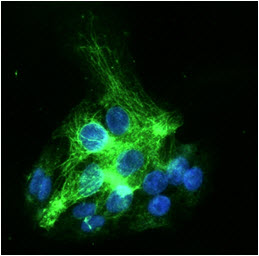
The cell lysates of MCF7 (40ug) were resolved by SDS-PAGE, transferred to PVDF membrane and probed with anti-human KRT19 antibody (1:1000). Proteins were visualized using a goat anti-mouse secondary antibody conjugated to HRP and an ECL detection system.The Cell lysates (20ug) were resolved by SDS-PAGE, transferred to PVDF membrane and probed with anti-human KRT19 antibody (1:1000). Proteins were visualized using a goat anti-mouse secondary antibody conjugated to HRP and an ECL detection system.Lane 1.: HepG2 cell lysateThe Cell lysates (5ug) were resolved by SDS-PAGE, transferred to PVDF membrane and probed with anti-human KRT19 antibody (1:1000). Proteins were visualized using a goat anti-mouse secondary antibody conjugated to HRP and an ECL detection system.Lane 1.: 293T cell lysateLane 2.: KRT19 Transfected 293T cell lysate

ICC/IF analysis of KRT19 in HepG2 cells line, stained with DAPI (Blue) for nucleus staining and monoclonal anti-human HepG2 antibody (1:100) with goat anti-mouse IgG-Alexa fluor 488 conjugate (Green).